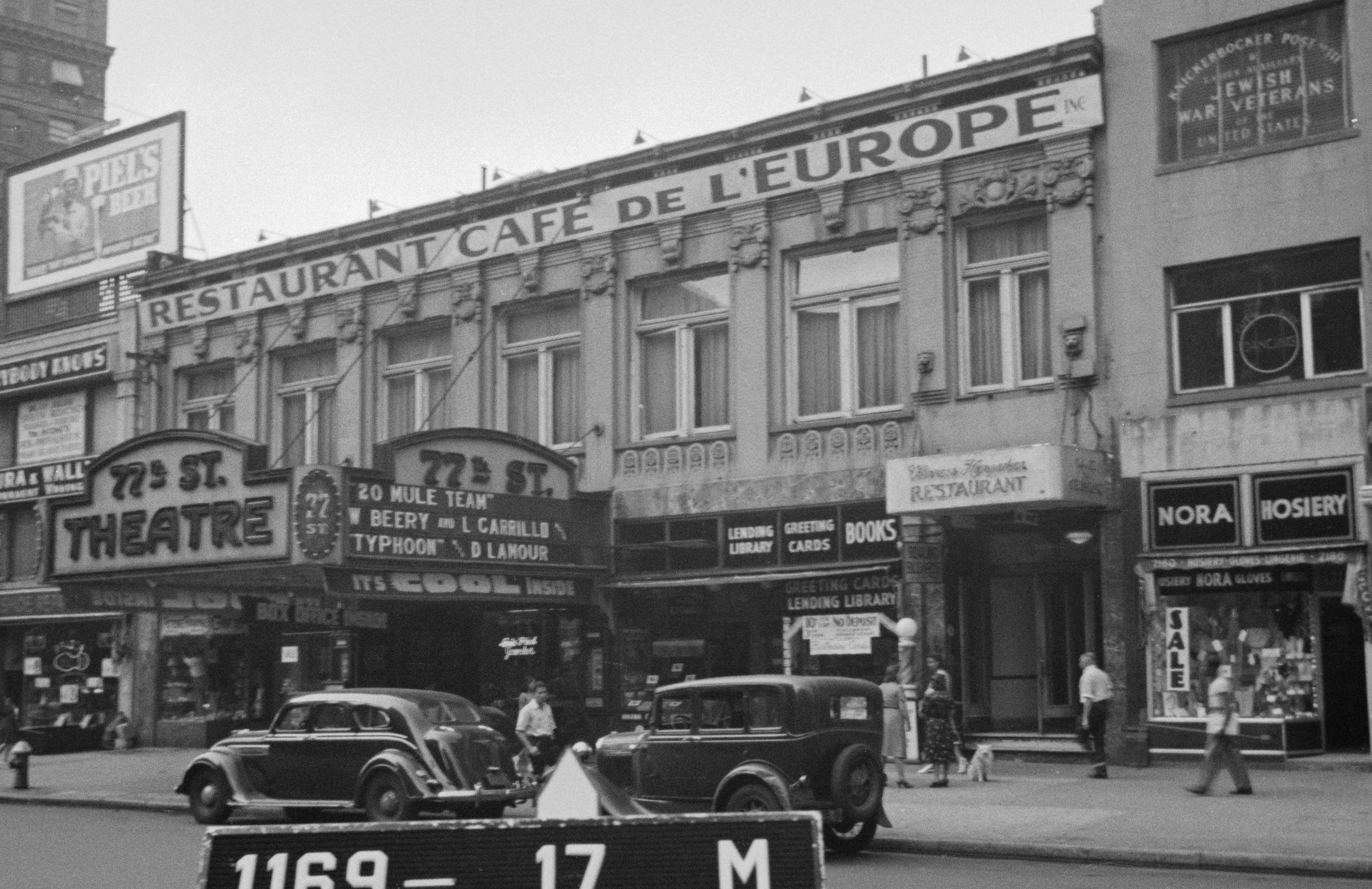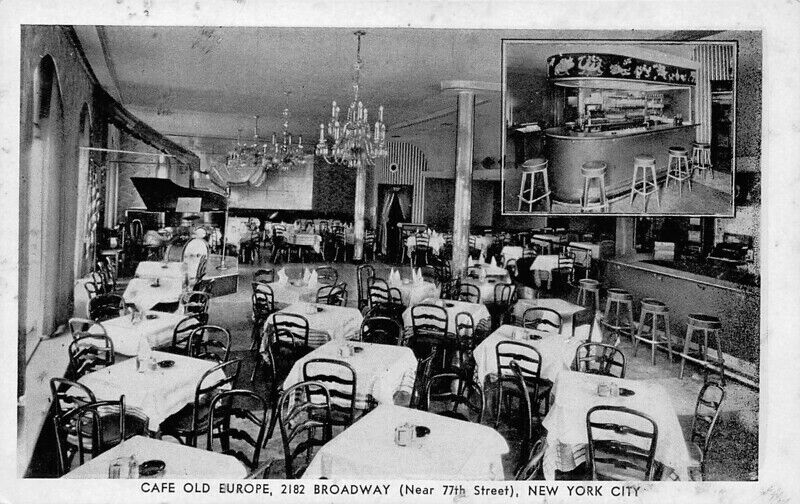
Springer’s 77th Street Theatre
by Tom Miller
In the summer of 1914 the Holmes Metropolitan Garage, a two-story structure on the east side of Broadway between 77th and 78th Street closed. The L-shaped structure also opened onto West 77th Street. On November 21 The Real Estate Record & Guide reported that the Continental Motion Picture Company had signed a 21-year lease on the property. The article said, “A moving picture theatre will be operated after the present structure has practically been rebuilt, with stores on Broadway.
The Continental Motion Picture Company sought the services of an up-and-coming theater architect, Thomas W. Lamb. His first commissioner for a theater had come in 1909 from William Fox, and he would go on to become one of America’s foremost theater designers of the 20th century. His plans for converting the old garage into a motion picture theater and stores placed construction costs at the equivalent of about $419,000 in 2022. Completed in 1915, the building was faced in stone above the first floor where commercial spaces flanked the wide theater entrance below an overhanging marquee. A separate entrance at the south end led to the building-wide rental space upstairs. Lamb decorated the face of the second story with Ionic pilasters dripping bellflowers, and with garlanded keystones.
The theater was operated by the Springer Service, which named it Springer’s 77th Street Theatre. The rental spaces filled immediately. In 1915 the upper floor was home to the King Joy Lo Chinese restaurant. (Remaining here for years, it was described in a 1919 advertisement in The Chinese Students’ Monthly as “The finest, most famous and richly furnished Chinese restaurant in the City.”) At ground level were Madame Atamer, a milliner; a tailoring shop with the unlikely name Photo Brothers; and the haberdashery store of Mr. DeBarge. The two spaces in the basement were rented to “H. A. Rice, an experimenter and inventor,” and carpenter John Stewart.
The Continental Motion Picture Company sought the services of an up-and-coming theater architect, Thomas W. Lamb.
On September 17, 1915, Variety mentioned the opening of the 77th Street Theatre, which “plays pictures.” The article said, “A five-reeler was the feature Monday afternoon. Matinees are 10 cents, nights, 20…The house seats about 600.”
Silent motion pictures required live accompaniment. In small theaters a piano would do, but in first-rate venues like the 77th Street Theater, there was a small orchestra. Later, in 1921, the theater manager advertised for a “violin leader with large library; must be strictly first class and steady,” and an advertisement on December 22, 1925, sought a harmonium (a small reed organ) player.
In the meantime, the playing of popular music without paying for the rights landed the theater’s proprietors in court. On October 31, 1917, The New York Clipper reported, “The Broadway Music Co. has begun suit to enjoin the Seventy-seventh Street Theatre, at 2182 Broadway, from playing their music and to pay a certain amount for each time their songs have already been played.”
America’s entrance into World War I sparked propaganda films masked as entertainment. On October 30, 1918, the 77th Street Theatre was screening Charlie Chaplin’s Shoulder Arms, and The Hun Within, starring Dorothy Gish. The blurb for the latter read, “Nothing is sacred to the German spy in our midst, love, honor or sanctity of the home; and so the American-born son of a German-American father became a Hun, while the father stood up for his adopted country.”
The King Joy Lo Restaurant closed around 1922. It seems that the building’s owners felt that the sprawling second-floor space was perfect for a different Jazz Age use. In August an advertisement in the New York Herald touted a “Dance Palace on Broadway” available. It became home to the Café Old Europe, a “first-class Viennese café.” An orchestra played during dinner for dancing. It advertised an “After Theatre Supper with complete Smorgasbord served till closing.”
Louise J. Fried’s jewelry store occupied one of the ground floor stores in 1930. On June 29 two men entered and one of them asked Fried to show him some jewelry. When Fried turned his back, the other man hit him over the head with a gun. The pair scooped up diamond bracelets and a diamond ring valued at between $5,000 and $5,500—nearly $90,000 today—and escaped in a car driven by a get-away man. The thieves pressed their luck by going directly to a Park Avenue store. In a scuffle there, one of the thugs shot the proprietor. As the trio fled, Patrolman Harold Roth shot 28-year-old David Fuchs dead. His accomplices were apprehended.
When the United States entered World War II, Café Old Europe gave way to a recreation center for servicemen, called the A. W. V. S. Park Hudson Recreation Center, which opened in 1942. But at the war’s end, on November 9, 1945, William Kantner reopened his Café Old Europe. The restaurant advertised “delicious dinners $1.50” (about $21 today) and featured a “matinee dansant” (an early afternoon dance), “enchanting music” and “delightful entertainment.” The Brooklyn Eagle wrote in part on December 21, 1945, “The entertainment is very gay. Sasha plays a beautiful violin and particularly delights the ladies with his charming rendition of Viennese pieces. Eugene Hoffman is a most amusing m.c. and really makes you laugh. The feminine entertainment includes Helen Olsen, tall and beautiful dancer, and Sandra Kiraly, who sings and does an interesting number in Turkish.”
At around 3:30 on the morning of April 8, 1950, Mrs. Gilda Rogers was at work in the food store that she and her husband owned at 2200 Broadway. Glancing out the window, she saw the reflection of flames in the shop windows across Broadway. The 77th Street Theatre was on fire.
The blaze had originated in the kitchen of the Old Europe Restaurant. Fire department officials reported that it had been gaining force for some time before Mrs. Rogers discovered it. Thomas W. Lamb’s elaborate interiors were gutted.
Glancing out the window, she saw the reflection of flames in the shop windows across Broadway. The 77th Street Theatre was on fire.
The former movie theater became a grocery store, first home to the Garden Food and Market, and then, in the early 1970’s to the Daitch Shopwell Supermarket. The Chamber Ballet U.S.A. occupied the upper portion of the building by the early 1980’s. The company was formed by Finish Jhung, a former member of the Harkness Ballet.
Ballet gave way to sports and beer in 1987 when Sports opened in 1987. Writing in The New York Times on February 19, Suzanne Slesin called it “one of the Upper West Side’s most original new restaurants,” saying “the 500-seat nightspot is a haven for the sports-minded, with its many televisions and giant video screens.” The sports theme was emphasized by a double row of bleachers from which patrons could watch games on the large screens.
In the meantime, the grocery store was renovated to house an Off-Broadway theater. The Promenade Theatre opened in 1995, staging performances like the 2002 play Mr. Goldwin starring Alan King.
Sports survived in the upper space until 1994, when it was replaced by Brother’s Barbecue, which was supplanted the following year by Mad Fish. Then, on January 23, 1999, the upstairs space came full circle when Ruby Foo’s Dim Sum and Sushi Place opened. The following year a scene from Woody Allen’s Small Time Crooks was filmed in the restaurant. Inside New York 2008 called the cuisine “pan-Asian” and described the restaurant as “a fun and delicious experience.”
But when that positive review was written, the days of Ruby Foo’s and the former 77th Street Theatre building were coming to an end. The Promenade Theatre closed in June 2006 after the last performance of Tryst, starring Amelia Campbell and Maxwell Caulfield. Three years later, in the summer of 2009, demolition began, and the vintage structure was replaced by an apartment building.
Tom Miller is a social historian and blogger at daytoninmanhattan.blogspot.com
Building Database
Keep Exploring
Be a part of history!
Think Local First to support the local business currently at 2182-2186 Broadway:



